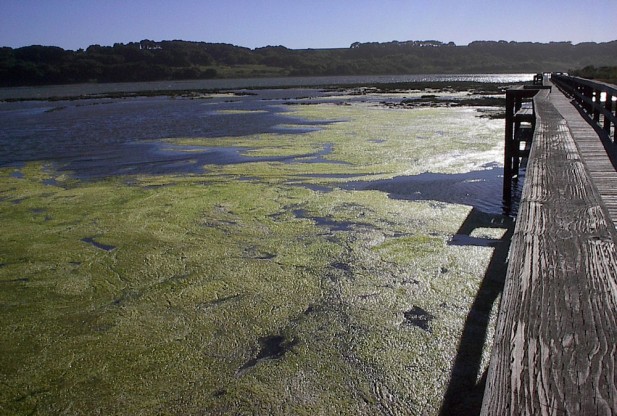
Image Caption: Superoxide-producing bacteria live in dark places like the depths of Elkhorn Slough, California. Credit: Scott Wankel, WHOI
Of all the things that could be hazardous to your health, would you believe breathing oxygen makes the list?
Our bodies produce toxic chemicals in our cells, called oxidants, which we fight naturally and with foods that contain antioxidants like blueberries and dark chocolate. All forms of life that breathe oxygen must fight oxidants to live, even those forms we can’t see with a naked eye, such as bacteria. “If they don’t,” says scientist Colleen Hansel of the Woods Hole Oceanographic Institution (WHOI), “there are consequences: cancer and premature aging in humans, death in microorganisms.”
There are also environmental oxidants, such as superoxide. Neutralizing environmental oxidants, though, were only a worry for organisms that dwell in sunlight – such habitats cover a mere five percent of the planet. Until now, those habitats were the only place such environmental oxidants were thought to exist.
The first light-independent source of superoxide has been discovered by a research team — including scientists from WHOI, Harvard University, and the Colorado School of Mines — who say the key is bacteria common in the depths of the oceans and other dark places.
These bacteria are oxygen breathing organisms, just like humans. “And they’re everywhere–literally,” says Hansel. The study findings, published in the journal Science Express, expand the known sources of superoxide to the 95 percent of the planet’s “dark” habitats. Surprisingly, 90 percent of the bacteria tested produced superoxide in the dark.
“Superoxide has been linked with light, such that its production in darkness was a real mystery,” says Deborah Bronk of the National Science Foundation’s (NSF) Division of Ocean Sciences (OCE), which co-funded the research with NSF’s Division of Earth Sciences.
“This finding shows that bacteria can produce superoxide in the absence of light,” says Bronk.
Hansel says the bacteria are found “miles beneath the seafloor, in hot fluids coming from underwater volcanoes, in every type of underground soil and throughout deep lake and ocean waters.”
More of these bacteria are present in a thimble of seawater or soil than the human population of San Francisco, and they are all releasing huge amounts of superoxide.
On Earth’s surface, “superoxide can kill corals, turning them white,” says Hansel. “It can also produce huge fish kills during red tides. But it’s not always bad.”
Superoxide also helps ocean microorganisms obtain the nutrients they need for survival, and it may remove the neurotoxin mercury from the sea. This would keep mercury out of fish, and off your dinner plate.
Superoxide producing bacteria could account for the total amount of the chemical in the oceans, and are more likely the main source in dark environments.
“That’s a paradigm shift that will transform our understanding of the chemistry of the oceans, as well as of lakes and underground soils,” says Hansel, “and of the life forms that live in and depend on them.”
